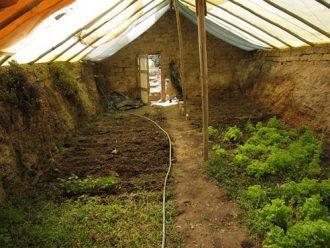Contributing Writer for Wake Up World
With staggering food prices and shortages looming, there’s no better time to grow your own produce. Sadly, most greenhouses are expensive to build and impractical to heat during cold, wintery conditions. Thankfully, a solution is found with the Walipini. Developed for South American mountainous regions over twenty years ago, it allows edibles to be grown year-round – even in the most inhospitable weather. As an added bonus, it’s also outrageously inexpensive to construct.
Unlimited growing season
Known as a pit or underground greenhouse, the Walipini utilizes the advantages of passive solar heating along with earth sheltering properties. The structure makes use of thermal mass energy, creating a highly efficient and cost effective method for heating the interior. Regardless of where you live, produce can be grown year round with the Walipini. According to the creators at the Benson Institute:
“The Walipini, in simplest terms, is a rectangular hole in the ground 6′ to 8′ deep covered by plastic sheeting. The longest area of the rectangle faces the winter sun — to the north in the Southern Hemisphere and to the south in the Northern Hemisphere. A thick wall of rammed earth at the back of the building and a much lower wall at the front provide the needed angle for the plastic sheet roof. This roof seals the hole, provides an insulating airspace between the two layers of plastic (a sheet on the top and another on the bottom of the roof/poles) and allows the suns rays to penetrate creating a warm, stable environment for plant growth.”
The Institute continues with an explanation of how the earth acts like a battery, storing heat during the day while releasing it during cooler nighttime temperatures:
Energy and light from the sun enter the Walipini through the plastic covered roof and are reflected and absorbed throughout the underground structure. By using translucent material, plastic instead of glass, plant growth is improved as certain rays of the light spectrum that inhibit plant growth are filtered out. The sun’s rays provide both heat and light needed by plants. Heat is not only immediately provided as the light enters and heats the air, but heat is also stored as the mass of the entire building absorbs heat from the sun’s rays.
The estimated building cost (using volunteer labor) for a 20 x 74 foot Walipini in La Paz, Peru is between $250 – $300. Taking advantage of inexpensive materials like PVC pipes and ultraviolet (UV) protective plastic sheeting add to the savings.
A detailed do-it-yourself building manual can be found here and includes crucial instructions for ventilation, waterproofing and drainage.
Sources for this article include:
Previous articles by Carolanne:
- Hemp – The Ultimate Cash Crop, Health Food and Environmental Savior Rolled Into One
- Confirmed by Science: You Really Can Change Your DNA – Here’s How
-
Chemtrails: Learn How to Protect Yourself From These Treacherous Poisons
- Kick the Caffeine Habit and Feel Better Quick with these Natural Alternatives
- Top 10 Food Frauds: Formaldehyde, Plastic, Melamine & Caustic Soda Found in Common Foods
- Autistic Boy With Higher IQ Than Einstein Discovers Gift After Removal From State-Run Therapy
-
Enhance Spiritual, Mental and Physical Well-being with a Pineal Gland Detox
About the author:
I’m Carolanne — a writer, chef, traveler and enthusiastic advocate for sustainability, organics and joyful living. It’s good to have you here. If you would like to learn more, connect with me at Thrive-Living.net or visit Twitter.com/Thrive_Living.Please note: this article was first published on Natural News.

If you've found value in our articles, we invite you to support the release of our brand-new book, "Gratitude Practices for Kids: A Practical Guide for Adults to Instill a Spirit of Appreciation and Positivity in the Next Generation."
"Gratitude Practices for Kids" brings together over 25 innovative and accessible practices designed to enhance gratitude in everyday life. This comprehensive guide is backed by 17 scientific studies, ensuring each concept is grounded in research, underscoring our commitment to nurturing growth, emotional intelligence, and positive interactions between adults and children.
We encourage you to opt for the paperback version to celebrate this new release. Dive into its fresh pages away from digital distractions, allowing you to immerse yourself in the transformative practices it offers.
Over recent years, Wake Up World has faced significant online censorship, which has impacted our financial ability to operate. Moving into book publishing represents a strategic step to secure the ongoing funds needed to continue our mission. By purchasing Gratitude for Kids, you help us keep our content free and accessible to everyone, avoiding needing a paywall. With over 8,500 articles published in the last 13 years, we remain dedicated to keeping our valuable content open to all.









